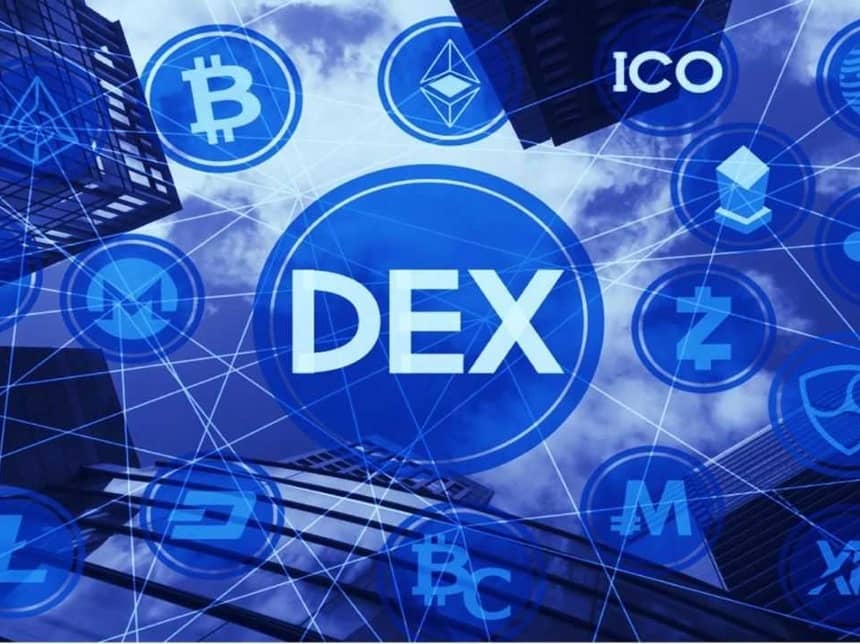订阅 wiki
Share wiki
Bookmark
Decentralized Exchange (DEX)
Decentralized Exchange (DEX)
去中心化交易所 (DEX) 是基于点对点 (p2p) 区块链 的平台,支持加密货币交易者之间直接进行加密货币交易。DEX 使用智能合约,在设定的条件下执行订单,无需中介,并将每笔交易记录在区块链上。[2][3][4]
概述
去中心化交易所 (DEX) 在没有中央机构的情况下运作,因此用户可以控制他们的私钥,因为他们在进行交易时无需存入资金或提交 KYC 验证。这降低了中心化黑客攻击和盗窃的风险,以及价格操纵的风险,因为用户的加密资产存储在 区块链 上。[1][5]
去中心化加密货币交易所旨在解决中心化交易所固有的问题。它们直接在 区块链 上创建点对点市场,允许交易者独立存储和控制资金。这些交易所的用户可以直接相互进行加密货币交易,而无需第三方的协助。[9]
去中心化服务由用户自动监督或手动监控。分布式账本技术 (DLT) 确保资产的安全。DEX 主要使用的区块链包括 以太坊 (EtherDelta, IDEX 等)、Graphene (BitShares, CryptoBridge 等) 或由其他 加密货币 驱动的区块链 (Waves, Switcheo 等)。[9]
去中心化交易所自动或在一定程度上自主运行,平台用户参与关键决策。这些平台提供直接参与者参与的技术能力,并采用分布式注册表来存储和处理所有或几乎所有数据。去中心化交易所仅作为匹配买家和卖家的平台,现金和用户数据都不会存储在其服务器上。[9]
技术
有几种DEX设计,每种设计在功能集、去中心化和可扩展性方面都提供不同的优势和权衡。两种最常见的类型是基于订单簿的DEX和自动化做市商(AMM)。DEX聚合器也是一种广泛使用的类别,它会解析多个链上DEX,以找到用户所需交易的最佳价格或最低gas成本。
DEX利用区块链技术和不可变的智能合约。它们通过智能合约和链上交易执行交易,并允许用户在交易期间通过其自托管钱包保持对其资金的完全保管。[10]
DEX用户通常需要支付两种类型的费用——网络费用和交易费用。网络费用是指链上交易的gas成本,而交易费用由底层协议、其流动性提供者、代币持有者或这些利益相关者的组合收取,具体取决于协议的设计。
许多DEX背后的理念是拥有一个无需许可、可访问的端到端链上基础设施,没有中心故障点,并且在分布式利益相关者社区中实现去中心化所有权。这通常意味着由利益相关者社区组成的去中心化自治组织(DAO)通过对关键协议决策进行投票来管理协议的管理权限。[10]
历史
尽管第一个去中心化交易所最初于2014年首次亮相,但这些平台直到建立在区块链上的去中心化金融服务普及,以及AMM技术使DEX能够克服其先前的流动性问题后,才真正开始流行。
2019年1月,DEX平台仅占全球交易量的0.11%,但到2020年8月,该数字随后增长到6%。截至2020年10月,去中心化交易所的月交易额为200亿美元。
根据TokenInsight的市场研究,2020年第三季度,去中心化交易所的交易额达到426亿美元,比上一季度增长了1,132%。但是,由于比特币价格开始飙升,重新引起了交易者的关注,因此10月份的数字略有下降,此前几个月去中心化金融蓬勃发展。仅7月份的交易额就达到50亿美元,占整个第二季度数字的三分之一。整个第三季度,月交易额持续增长,平均每月增长超过140%。[7][8]
2021年第一季度,去中心化交易所的交易额达到2170亿美元。截至2021年4月,有超过200万DeFi交易者,比2020年5月增加了十倍。[7]
最大的DEX Uniswap由一位前机械工程师于2018年在以太坊区块链上创建,他在前一年被西门子解雇后才学会了编码。到2021年末,它每天处理价值超过10亿美元的交易。 根据CoinGecko的数据,截至2022年2月,Uniswap的第3版协议在某些日子的交易量接近20亿美元。它通常管理的交易量是其最接近的DEX竞争对手(例如PancakeSwap)的三倍左右,后者通常每天处理3亿至6亿美元的交易量。[3]
截至2024年初,全球独特的DeFi用户数量一直在稳步增长。大约有8,992种不同的加密货币可供交易,DeFi平台中的总锁定价值(TVL)约为917.6亿美元。[19][20]
在经历了强劲的2023年第四季度之后,整个加密货币市值在2024年第一季度继续上涨+64.5%,达到2.9万亿美元的峰值,并通过去中心化交易所进行了交易。截至2024年,按总锁定价值(TVL)计算,顶级DEX是Uniswap、PancakeSwap、Curve、SushiSwap、SpookySwap、Cetus和QuickSwap。[6][21]
用例
加密货币交易
在DEX上,用户之间的点对点交易只能使用加密货币发起。法定货币在DeFi中没有用例,因此使用加密货币对(如ETH/USDT)进行加密货币之间的交易是唯一的交易方式。然而,稳定币的出现降低了DeFi的波动性,用户可以使用与单一美元价值挂钩的稳定币进行交易,本质上实现了法币交易。[11]
交易存储
去中心化交易所的交易直接在区块链上可见,使得每笔交易完全透明。虽然钱包地址是匿名的,但区块链允许任何有权访问的人查看所有交易。DEX也完全建立在开源代码之上,允许任何人查看它们的真实运作方式,Uniswap的代码被用于创建大量的其他DEX,例如Pancakeswap。[11]
DeFi 访问
去中心化交易所为进入DeFi世界提供了便捷的途径,允许用户匿名地将资金投入DeFi协议,例如质押,而无需通过中心化交易所。[11]
DEX 的类型
订单簿 DEX
订单簿会跟踪特定资产对的所有未结买卖订单。卖单显示交易者准备以特定价格出售资产,而买单显示交易者渴望以该价格获取或竞标资产。订单簿的大小和交易所的市场价格由这些值之间的差异决定。[12]
订单簿 DEX 有两种类型:链上订单簿和链下订单簿。
链上订单簿
链上订单簿直接托管在分布式账本上,所有订单都发送到分布式账本网络,并由网络在链上订单簿中确认。任何人都可以托管和访问订单簿的副本,只要分布式账本是公开的,任何人都可以提交自己的订单以包含在订单簿中。[4]
当DEX使用订单簿时,未结订单信息通常保存在链上,而用户资金保存在他们的钱包中。这些交易所可能允许交易者使用平台上贷方借给他们的资金来杠杆他们的头寸。杠杆交易增加了交易的盈利潜力,但同时也增加了清算的风险,因为它用借来的资金扩大了头寸规模,即使交易者输了,也必须偿还这些资金。
使用链上订单簿的去中心化交易所的例子包括BitShares和Stellar。[12]
链下订单簿
链下订单簿是由中心化实体托管在分布式账本之外的订单簿。中心化实体帮助各方发现其他对资产进行报价的各方,并可以限制访问以查看或提交到订单簿。使用链上或链下订单簿的实用性在很大程度上取决于链的性能。鉴于对链上订单簿的每个订单和调整都需要更新区块链,从而产生交易费用和等待时间,因此去中心化交易所通常不采用链上订单簿。
在某些链上,交易费用可以忽略不计,等待时间约为几秒钟。在这种情况下,链上订单簿对于适度数量的间歇性订单是实用的。相比之下,在以太坊区块链上,交易费用不可忽略,等待时间约为几分钟。使用以太坊链上订单簿可能会产生昂贵的交易费用和令人衰弱的等待时间。因此,以太坊上一些著名的去中心化交易所使用链下订单簿,例如 0x 协议、AirSwap、EtherDelta 和 IDEX。[12]
自动做市商 (AMM)
自动做市商 (AMM) 系统是为了解决流动性问题而创建的,它依赖于智能合约。这些交易所的部分灵感来自于以太坊联合创始人 Vitalik Buterin 撰写的一篇关于去中心化交易所的论文,该论文解释了如何使用持有代币的合约在区块链上进行交易。[13]
这些 AMM 依赖于基于区块链的服务,称为区块链预言机,通过从交易所和其他平台收集数据来确定交易资产的价格。这些去中心化交易所的智能合约使用预先注资的资产池(称为流动性池),而不是匹配购买订单和出售订单。
这些资金池由其他用户提供资金,然后他们有权获得协议对在该交易对上执行交易收取的交易费用。这些流动性提供者需要存入等值的交易对中的每种资产,才能赚取其加密货币持有量的利息,这个过程称为流动性挖矿。为资金池提供支持的智能合约会使任何试图存入超过另一种资产的尝试无效。
流动性池的使用允许交易者以无需许可和信任的方式执行订单或赚取利息。这些交易所通常根据锁定在其智能合约中的资金量进行排名,称为总锁定价值 (TVL)。一些流行的 AMM DEX 包括 Fraxswap、Bancor、Balancer、Curve、PancakeSwap、Sushiswap、Trader Joe、Uniswap、Raydium、Aerodrome Finance 和 1inch。 [10][22]
预测市场 AMM
预测市场使用自动化做市商,以便它们充当“庄家”,承担所有交易的对手方。这样做可以确保参与者始终能够进行交易,从而有效地创建或“制造”市场。为了制造市场,平台必须为每只股票设定价格。价格通常使用市场评分规则设定,市场评分规则是指为股票生成价格和交易成本的数学方程式。[14]
时间加权自动做市商 (TWAMM)
时间加权自动做市商 是去中心化交易所 (DEX) 的一部分,它允许交易者以最小的滑点和低 gas 成本执行大额订单,而不会降低价格。[23]
传统金融中的交易者经常使用经纪人以算法方式在设定的时间范围内执行大额订单,以期获得最佳价格。时间加权平均价格 (TWAP),即证券在指定时间内的平均价格,是执行此操作的最直接方法。TWAMM 试图通过在一段时间内将它们分解成几乎无限数量的小订单通过自动做市商 (AMM)来复制 TWAP 订单。[23]
手动分解交易是一种耗时的方法,由于需要多次交易而产生额外的 gas 费用。TWAMM 试图通过自动化小额交易并最大程度地提高交易执行的流畅性同时降低 gas 成本来克服这个问题。TWAMM 是 DeFi 中首批允许用户指定他们想要在特定时间段内购买或出售多少资产,而无需前往 CEX 或交易台的算法之一。[23]
Fraxswap 是第一个具有嵌入式时间加权平均做市商 (TWAMM)的恒定乘积 自动做市商,用于在长时间内以无需信任的方式进行大额交易。[24]
该去中心化交易所 (DEX)是完全无需许可的,因为核心 AMM 基于 Uniswap V2。Fraxswap 旨在帮助交易者更有效地执行大额订单。嵌入式 TWAMM 基于 Paradigm 的原始白皮书规范。TWAMM 旨在随着时间的推移缓慢而可靠地交换资产,以减少滑点。Fraxswap 实现了 Paradigm 原始公式的近似公式,并允许简化、更节省 gas 的 TWAMM。[25][24]
DEX 聚合器
去中心化交易所聚合器是一种交易协议,通过根据特定需求在多个 DEX 中寻找和路由流动性来工作。这些平台本质上聚合了来自多个 DEX 的流动性,以最大限度地减少大额订单的滑点,优化交换费用和代币价格,并在最短的时间内为交易者提供最佳价格。因此,DEX 聚合器不需要专门从自己的流动性池为交易者提供服务。[15]
一些流行的 DEX 聚合器包括 1inch、ParaSwap、OpenOcean 和 Orion Protocol。[16]
DEX 列表
以下是一些流行的 DEX 列表:[17]
发现错误了吗?
